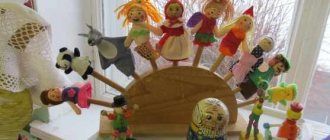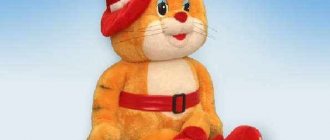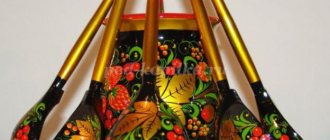Summary of educational activities for familiarization with the fairy tale “Teremok” (first junior group)
Yulia Pyryeva
Summary of educational activities for familiarization with the fairy tale “Teremok” (first junior group)
Goal: Continue acquaintance with the Russian folk tale “ Teremok ”
through theatrical activities.
— teach to listen carefully to a fairy tale , accompanied by a display of tabletop theater figurines.
- contribute to the formation of children’s ability to reflect some game actions and imitate the actions of characters, convey simple emotional states of characters, using at least one means of expressiveness - facial expressions, gestures, movement (smiles, makes a scared face, shakes his head, waves his hands, etc.) ;
- develop coherent speech, attention, memory, logical thinking;
— cultivate emotional responsiveness; a friendly attitude towards theatrical activities.
Materials and equipment: magic chest, leaves on Christmas tree ribbons, heroes of the fairy tale “ Teremok (table theater, two towers
Notes on speech development in the younger group, fairy tale “Teremok”
Antonina Bobrova
Notes on speech development in the younger group, fairy tale “Teremok”
Developed by: Teacher of GBDOU No. 52 of the Primorsky district Bobrova Antonina Igorevna
Technologies used: Gaming
Goal: Creating favorable conditions for creative activity in children through theatrical activities.
NGO "Speech Development"
1. Teach children to pronounce words clearly and distinctly, develop intonation expressiveness.
2. Formation of vocabulary: activate the words in children’s speech - terem-teremok, mouse-norushka, frog-frog, bunny-runner, little fox-sister, top - gray barrel, clubfooted bear.
NGO "Social and communicative development"
1. Encourage children to actively participate in theatrical play.
2. Develop the ability to coordinate actions with other children - the heroes of the fairy tale.
3. Cultivate goodwill and friendly relationships.
NGO "Physical Development"
1. Contribute to the development and enrichment of children’s motor experience.
Demonstration material: reproductions of paintings (illustrations for the fairy tale “Teremok”) by artists Yu. A. Vasnetsov, Evgeny Charushin, E. M. Rachev, A. Komarov.
• reading and discussion of the Russian folk tale “Teremok”;
• selection of subject paintings and reproductions by Russian artists for viewing for the fairy tale “Teremok”;
• table theater, fairy tale “Teremok”;
• fairy tale “Teremok” on flannelgraph.
GCD content
Introductory part (3 minutes).
The teacher and the children stand near the blackboard. On the board are illustrations depicting scenes from the fairy tale “Teremok”.
Educator. Guys, I was recently sorting out old things and found interesting pictures from my childhood. I even remember my grandmother telling me a fairy tale based on them. But I don’t remember what kind of fairy tale it was... (Children’s answers)
Yes, right! These are illustrations for the fairy tale “Teremok”.
Educator. Look at these illustrations, how interesting they are. What beautiful outfits on the fox, the bunny, the wolf... They are wearing Russian folk costume: sundresses, shirts, bast shoes on their feet.
Educator. Guys, I suggest you turn into the heroes of a fairy tale to remember it! Who wants to go to a magical clearing? We have wonderful costumes in our group. Let's change clothes.
Main part (9 minutes).
Educator. Let's sit in a circle in a magical clearing. (Children sit on the carpet with the teacher)
Stands in the Teremok field,
He is neither low nor high,
Educator. Guys, who was the first to run to Teremok?
Educator. That's right, mouse.
Educator. Let's try to portray her! How does the mouse squeak? (Children show with sounds)
Stands in the Teremok field,
He is neither low nor high,
Here he is jumping across the field...
Educator. Guys, who came to Teremok next?
Educator. Right! Let's show, guys, how frogs jump and croak... (Children show)
Well done! You're doing great!
Educator. The mouse invited the frog into the little house and they all began to live together.
Stands in the Teremok field,
He is neither low nor high,
Children. The bunny is running!
Educator. Right! Where are our bunnies? How do bunnies jump? (Children show)
Educator. And the bunny also began to live in the little house!
Stands in the Teremok field,
He is neither low nor high,
Educator. And who came running after the bunny?
Children. Chanterelle!
Educator. Absolutely right! Chanterelle.
Educator. Show me, guys, your cunning little fox. (Children show)
That's how foxes are!
Educator. Guys, do you think the fox was invited to the little house? (Children answer yes)
Surely! You are absolutely right!
Stands in the Teremok field,
He is neither low nor high,
Educator. Who's running this time?
Children. Wolf!
Educator. Yes, that's right, it's a wolf! What kind of wolf is there? Let's show! (Children show)
Educator. It even became scary how many wolves we have... And the wolf also began to live in the mansion and protect its inhabitants.
Stands in the Teremok field,
He is neither low nor high,
Educator. Guys, who came last to the tower?
Children. Bear!
Educator. Right! Show me the clumsy bear! (Children show)
Educator. Guys, what did the bear do? (Children answer that he broke it) Yes, that's right! He broke the tower... (Children stomp their feet, imitating the actions of a bear)
. The bear was upset to the point of tears.
Stop crying, little darling!
How long can you sit like this?
We need to build a new house -
Let's all live together in it!
Educator. Well done guys, they helped me remember the fairy tale!
Educator. Guys, what is your favorite moment in the fairy tale? Let me read it to you again. (The teacher rereads at the request of the children)
Subtexts and meanings in the fairy tale “Teremok”
Background
The fairy tale “Teremok” has many interpretations among many peoples of the world. For the first time, three versions of a Russian fairy tale were recorded and published in the collection of Russian fairy tales by A.N. Afanasyev in 1855–1873.
Many storytellers and folklorists have diluted the invariant plot with their own details. Thus, the versions of A.N. are known. Tolstoy, M. Bulatov, V. Suteev, V. Bianchi. Particularly noteworthy is the version of M. Bulatov, who changed the ending of the fairy tale by adding the restoration of the mansion to the plot.
What is important to highlight in the plot of the tower?
The fairy tale “Teremok” is quite simple in terms of plot. The first three options, recorded by A.N. Afanasyev, differ in small details. We have summarized the main points of the fairy tales in a table:
| A fairy tale in the collection of A.N. Afanasyeva | Fairy tale number 82 | Fairy tale number 83 | Fairy tale number 84 |
| View of the tower | “A mansion was built by a fly” | Jug | Horse head |
| Who lived in the tower | burn fly snatch from under a bush wolf gray tail | buzz fly mouse whining from around the corner frog on the water balagta hare on the field fox on the field beauty wolf from behind the bushes | little mouse the hare on the mountain is dodging the fox is jumping everywhere wolf grabs from behind the bushes |
| Who destroyed the tower | thick-legged bear | forest oppression bear | the bear is crushing all of you |
| How the tower was destroyed | pawed down the tower and broke it | He sat on a jug and crushed everyone | sat on his head and crushed everyone |
As can be seen from the table, differences in fairy tales do not affect the plot in any way. It is important to note that the heroes of the fairy tale are various animals who, if not enemies with each other in the real world, are at least not friends.
The fairy tale “Teremok” is quite simple in terms of plot. The first three options, recorded by A.N. Afanasyev, differ in small details. The differences in the tales do not affect the plot in any way. It is important to note that the heroes of the fairy tale are various animals who, if not enemies with each other in the real world, are at least not friends. You can tell by their size that they appear. But the tower could accommodate everyone except the bear.
The key to admission to the tower is the consent of those already living in it. Note that none of the animals objects to the appearance of a new tenant. Here lies an important attitude towards your neighbor: it doesn’t matter whether he is your friend or your enemy, it is no coincidence that at a certain point in your life it was he who appeared in front of you: perceive him as a reward - if he is a good person, perceive him as a test - if he is a bad person.
What is the tower an image of?
The object of the mansion itself is not revealed in the fairy tale: whether it is a jug or a horse’s head, there is no further description of the mansion as a dwelling as it is unnecessary, that’s not the point.
In the initial understanding, the tower in a fairy tale is an image of a house that shelters everyone who comes. As a rule, a person associates home with peace and tranquility. It is peace that is the hidden maxim of the tower, under the roof of which so many different animals gather and live peacefully in it. How can one not remember the phrase of St. Seraphim of Sarov:
“Obtain a peaceful spirit and thousands around you will be saved.”
Look, the fairy tale indirectly conveys the idea of the importance of the inner world - this is achieved by the fact that the animals friendly welcome every animal that comes into the house, in other words, they are internally reconciled. And through the inner world comes the outer world, because the animals lived in harmony before the arrival of the bear. In other words, we can conclude that the world (as a spiritual concept) is also a certain connotation of the mansion.
Another important detail is that the fairy tale does not indicate any additional external attributes of the life of animals in the tower, but we know that if something is silent in the fairy tale, then it matters. In this case, the silence highlights the friendly attitude of those living in the tower towards newcomers. In fact, this is the only thing that is shown in the fairy tale, repeating itself every time with the next animal.
- I, little mouse; and who are you?
- And I'm a frog.
- Come live with me.
A frog came in and the two of them began to live together.
That is why the spatial significance of the tower is not indicated in the fairy tale, or rather, it is indicated as obviously small, since it is very important to show the internal attitude of the inhabitant of the tower to the newcomer. In other words, the message is conveyed - don’t think about how much space you have in your home, whether it’s a lot or a little - this is not what is required of you. But it turned out that all the animals fit into the little house, although if you imagine that a wolf, a fox and a dog fit into a jug, then some kind of logical absurdity arises. This is the simple but most important idea of the fairy tale! Be ready to help everyone who comes and asks. Don't rely only on your own strength and thoughts! God will arrange everything! It’s the same in life: some things seem unthinkable, but you just have to rely on God, and the situation will resolve itself.
Why didn't the bear get in?
The tale ends with the appearance of a bear that destroyed the tower. Of course, the bear is presented in the role of a destroyer for a reason. The bear in Rus' was revered as the most powerful animal, the owner of the forest. Nicknames that are used in fairy tales emphasize his strength and superiority over other animals: “forest oppression”, “he crushes you all”, “thick-legged”. The people knew very well what position the bear occupied in the forest; naturally, this is not the same idea of the clumsy, clubfooted good bear that developed during the Soviet period (more on this below) in the contamination of fairy tales. The bear is the most dangerous predator of the forest, in other words, it is the enemy of all animals, or more precisely, an oppressor , because... No one can resist him, except perhaps another bear.
If we transfer the image of a bear to a person, then what can we say about the feelings of a person who is such a “bear” in relation to other people? Such a person may develop evil feelings: envy, hatred, despair, intransigence, enmity. In other words, the image of a bear personifies the vices of human hostility towards society.
The bear can also be compared to an unrepentant sinner, who, as we know, will not go to Heaven. To some extent, an allusion to Paradise can be called a mansion into which a bear cannot get.
In the fairy tale, a bear comes to a tower and does not yet know who lives in it, i.e. Evil in a bear cannot manifest itself in any way. Next, the bear asks who lives in the little house, thereby getting an idea about those living in it (remember that each animal had its own nickname). It was after he recognized all his “friends” that the bear destroys the mansion, because he sees his enemies in its inhabitants and is not ready to reconcile with them. Thus, the collapse of the tower is the expression of the bear’s despair in its anger. Hence the bear’s phrase at the end:
- I’m a bigot, I’m a bully for everyone! - said the bear, put his paw down the tower and broke it. (tale 82)
He sat on the jug and crushed everyone. (tale 83)
- And I’m crushing all of you! — sat on his head and crushed everyone. (tale 84)
Thus, the narrator seems to be hinting: do not be a bear, for you will not be saved, “acquire a peaceful spirit,” like other animals.
Specifics of the Soviet understanding
The original invariants of the tales about “Teremka”, recorded by Afansiev, although they have differences in form, do not change their meaning in content. The same cannot be said about later variations of the tale, mostly Soviet.
Thus, in Soviet versions, the instructive tale about “Teremka” turned into a tale about friendship and mutual assistance, thereby deeply reworking the meaning of the tale.
Most of all, M. Bulatov (1913-1963) modified (rather reduced) the original text. First of all, the image of the bear changed, he became a kind bear - a clubfooted one. At the same time, the bear does not oppose the animals, and also tries to get into the tower, but due to its size it cannot. And he crushed it by accident, trying to climb onto the roof... All these innovations destroy the previous model of the fairy tale, the apotheosis of which is the ending of the fairy tale:
The tower crackled, fell on its side and completely fell apart.
We barely managed to jump out of it: a little mouse, a frog, a little bunny, a little fox, a little sister, a top and a gray barrel - all safe and sound.
They began to carry logs, saw boards, and build a new mansion. They built it better than before!
With this ending, the author creates a new moral meaning of the tale and does not really hide it, apparently acting in the spirit of that time (according to the demands of that time). Now the tale ends on a positive note, instead of the bear's despair, we see how all the animals, including the bear, began to build a new house. The message here is that you need to see everything through to the end, don’t despair if something doesn’t work out, you need to be enthusiastic about your work, and treat the other person with understanding. Of course, these are good values, but the subtext of the fairy tale has become somewhat simplified.
Source
Semantic reading: analyzing the fairy tale “Teremok”
Russian folk tales are the very first works that children begin to get acquainted with.
“Teremok” is a fairy tale where the main characters are animals. There are several versions of the tale. This development considers a fairy tale with a happy ending. Together, the heroes build a new spacious house that can accommodate all the animals, including the bear.
I will give a procedure for working with text in a lesson or during extracurricular activities with students. In addition, a comment is given for each task:
Analysis of the fairy tale “Teremok”
At the moment of the Bear’s arrival, a complete restructuring of the child’s personality occurs, after which he reaches a new psychologically conscious level of development, having conducted introspection (in this case, reconstruction of the home, the topic of building a new Teremok).
The main idea of the story can be expressed as follows: the existing set of different activities is transformed into a coherent, meaningful activity, set by a single goal. In this case, it is the construction of a new Teremok. All animals together build a new home for themselves, in which they live peacefully and harmoniously.
Source
Main characters
The animals in the fairy tale were not chosen by chance. The mouse has always been a key figure in Russian fairy tales. It’s worth remembering, for example, “Rocktail Chicken” or “Turnip”. First and foremost, she is a seeker. It is no coincidence that she is the one who finds Teremok and is the first to move into it. The next character - a frog - symbolizes speech activity (this characteristic is most important for interaction with the outside world). Then Bunny appears - he is very active , but at the same time he is not without caution.
After this, larger animals (fox, wolf) come. They are predators by nature, but they coexist quite peacefully in the same territory with small animals. The Fox and the Wolf seem to bring the child's development to a new level of maturation , when his personality becomes multifaceted (a little cunning and not as simple-minded as before).
But the main event of the tale is the arrival of the bear. It personifies that very “point of no return” when the common house can no longer accommodate everyone and inevitably breaks down.
Summary
The general composition of the fairy tale “Teremok” remains the same in all versions: the empty space - a jug, a horse's head, a house - is inhabited in turn by various animals until it cannot withstand so many inhabitants and breaks down. The very first version of this tale was written down by A. N. Afanasyev back in 1855-1873. Many Russian writers (E. Charushin, M. Bulatov, V. Suteev, V. Bianchi) slightly changed its main content, and especially the ending, leaving the meaning, meaning and morality unchanged.
Briefly, the outline of the tale can be presented as follows:
The fairy tale teaches children to interact with the world around them. It talks about mutual assistance, about being tolerant of others, no matter how different everyone is from each other. After all, if they wish, everyone can live together and successfully interact with each other. Even the hare and fox, which are hostile in the wild, coexist amicably in Teremok. However, the main idea is how important it is to have a sense of proportion.
The simplicity and simplicity of this work invariably arouses the interest of very young children. It is no coincidence that it is considered one of the most popular in kindergartens. It is also unique in that, depending on the audience, it can be told briefly or filled with different characters and details for older children, as well as change the setting where all the events take place. ’s not for nothing that it is recommended for compulsory reading in grade 1 and is included in the reader’s diary.
This simple tale can be interpreted quite deeply. From the point of view of child psychology, Teremok represents a child’s personality , which consistently masters various skills. With the appearance of each hero, the child moves to the next stage in his development. Over time, the child’s soul and consciousness begin to present a complex structure in which all the characters interact.



